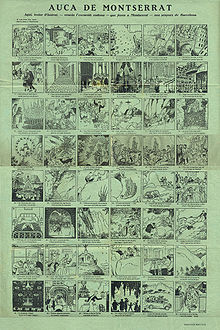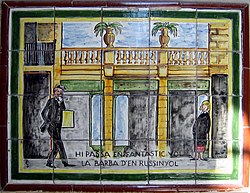Auca

An Auca (plural Auques ) is a picture story from Catalonia , which describes a historical event , a biography, a legend or the like in mostly humorous or satirical form. The individual images are typically accompanied by a two-line verse . The Auques are a form of expression of the popular, traditional literature of Catalonia, the so-called literatura de fil i canya (in German about "thread and reed literature"). They represent an early form of comics .
shape
An auca traditionally consists of 48 individual pictures arranged in boxes on a sheet. The drawings have a size between 6 × 6 cm to 8 × 8 cm, the entire sheet 40 × 30 cm to 60 × 40 cm (i.e. folio or large folio format , roughly equivalent to today's A3 to A2) . Auques with only 24 pictures are rarer. The illustrations are each accompanied by a caption in the form of a two-line verse, called rodolí . At times there is another two-line verse at the head of the bow that serves as an introduction to the story.
Origin and history

The spread of the Auques begins in the 17th century. It is believed that the picture arches, like their name, developed from the game of goose - in Catalan Joc de l'oca , in Northern Catalonia Joc de l'auca .
The oldest known Auca is the Auca del Sol i de la Lluna ("Auca of the Sun and the Moon") from 1676. It was created by the printer and illustrator Pere Abadal from Moià and shows a number of figures, animals, Mythical creatures and stars. A special feature here is the rarely encountered use of round image fields. These oldest auques, called auques arcaiques ("archaic auques"), did not yet have the form of a story and were not accompanied by text. Representations from the field of mythology or handicrafts and trades, the arts i oficis , are often found on traditional Catalan wall tiles - similar to the azulejos .
At the end of the 18th century a new type of auques appeared, the so-called auques primitives ("primitive auques"), with motifs from the field of children's games, holidays and processions , animal and plant species or soldiers' life. The images are now given numbers or names.
In the 19th century, the readers and the themes of the Auques finally multiplied, which now also illustrate fables , moral stories, biographies, plays, historical events and the like. At this time the use of verses as captions in the form of two or three lines became common. As the auques became more widespread, they became a profitable business - they were sold in stationery and bookstores, as well as haberdashery and kitchenware stores. Among the most successful Auca publishers were Josep Piferrer and Ignasi Estivill from Barcelona , Augustí Laborda and Joan Llorens from Valencia , Miquel Homs from Girona and Blai Bellver from Xàtiva .
In Castile , the Auques spread under the name Aleluyas from the middle of the 19th century . a. also very popular with the Spanish royal court.
At the turn of the century, the production of the Auques suffered a significant slump, as a result of which few new works were published and mainly old motifs of the Auques arcaiques and primitives were reproduced. From the 1920s, however, the picture stories experienced a renaissance and are still very popular to this day. Older or rare Auques have become coveted collector's items that can fetch high prices.
Due to their artistic quality or social importance, the following Auques are outstanding examples of their kind:
- Auca del noi antifeixista i humà (1937) - Auca of the anti-fascist and humanist boy
- Auca de les festes de l'entronització de la Mare de Déu de Montserrat (1947) - Auca of the celebrations for the enthronement of the Mother of God of Montserrat
- Auca d'en Pompeu Fabra (1969) - Auca by Pompeu Fabra
Others
In his novel and play L'auca del senyor Esteve ("The Auca of Mr. Esteve"), Santiago Rusiñol describes the life of a staid business owner who gets into conflict with his son when he refuses to continue the family business and decides to devote himself to art to dedicate.
literature
- Gran Enciclopèdia Catalana . 2nd Edition. Editorial Enciclopèdia Catalana, Barcelona 1986–1993, ISBN 84-85194-81-0 .
Remarks
- ↑ The line of verse reads: " Hi passa en fantàstic vol, la barba d'en Russinyol ." In German, for example: "It flies by really great, the beard of Rusiñol."

